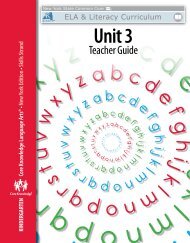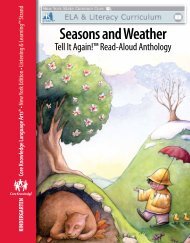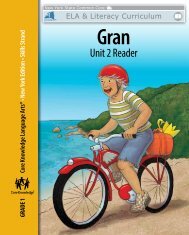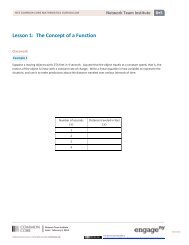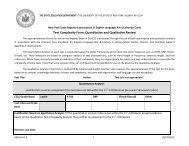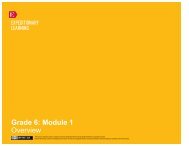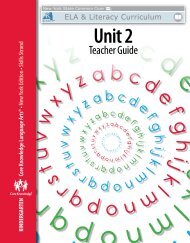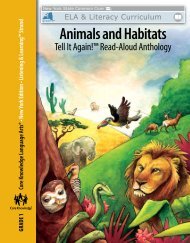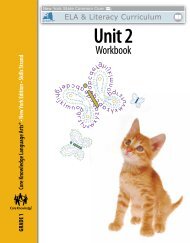Skills Unit 2 Teacher Guide - EngageNY
Skills Unit 2 Teacher Guide - EngageNY
Skills Unit 2 Teacher Guide - EngageNY
You also want an ePaper? Increase the reach of your titles
YUMPU automatically turns print PDFs into web optimized ePapers that Google loves.
• Start a stopwatch or jot down a start time when the student reads the first<br />
word in the story.<br />
• As the student reads, take a running record, using the following marking<br />
guidelines. Focus specifically on what a child’s errors reveal about his or her<br />
knowledge of letter-sound correspondences, recording what the student says.<br />
Note: These guidelines for taking running records represent a simplified<br />
version of the process. If you have mastered a different process of<br />
annotating running records, please use the system you know.<br />
Words read correctly<br />
Omissions<br />
Insertions<br />
Words read incorrectly<br />
Self-corrected errors<br />
<strong>Teacher</strong> supplied word<br />
no mark required<br />
draw a long dash above the word omitted<br />
write a carat (^) at the point where the<br />
insertion was made<br />
write an “x” above the word and if posssible<br />
the word the student says<br />
replace original error mark with an “SC”<br />
write a “T” above the word (counts as an<br />
error); provide only if the child hesitates for<br />
five or more seconds or says he/she does<br />
not know the word<br />
• When the student completes the reading, jot down the elapsed time or the<br />
finish time.<br />
• Ask the student a few questions about the story to quickly assess<br />
comprehension. Note the student’s answers on the back of Worksheet 16.3.<br />
Discussion Questions on “The Fox and the Cat”<br />
1. Literal Who are the characters of the story? (The characters in the<br />
story are a fox and a cat.)<br />
2. Inferential Where were the characters when they were talking? (The<br />
characters were talking at the river.)<br />
3. Literal The fox brags that he has many tricks. Can you name some of<br />
his tricks? (He can run, swim, dig a hole and hide.)<br />
4. Literal How many tricks did the cat have? (The cat had one trick.)<br />
5. Inferential When the cat heard hunting dogs, it ran up the tree. What<br />
did the fox do? What happened? (It could not decide what to do; the<br />
dogs got the fox.)<br />
6. Literal What is the moral of the story? (It’s better to have one trick you<br />
can count on than a hundred you can’t.)<br />
134 <strong>Unit</strong> 2 | Lesson 16<br />
© 2013 Core Knowledge Foundation



